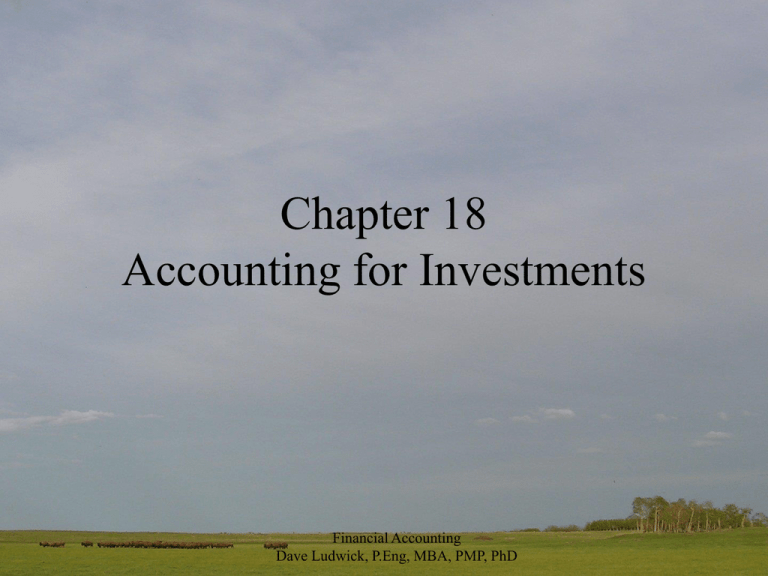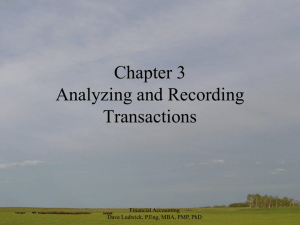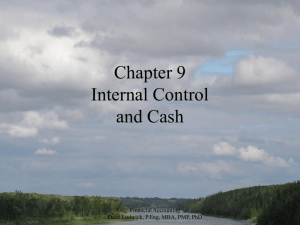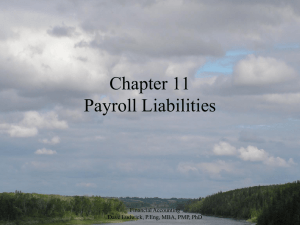Organizational Behaviour Course 5587WI2
advertisement

Chapter 18 Accounting for Investments Financial Accounting Dave Ludwick, P.Eng, MBA, PMP, PhD In this chapter… Balance Sheet Current Assets Cash Chapter Current Liabilities 10000 Accounts Payable Accounts Receivable 20000 Wages Payable Notes Receivable 15000 Utilities Payable Marketable Securities Inventory 18 120000 2000 Notes Payable 20000 Bonds Payable 600000 Equipment 250000 Owner’s Equity Buildings 500000 Total Assets 25000 25000 Long-Term Debt Capital Assets Goodwill 5000 60000 Common Stock 300000 Retained Earnings 48000 1000000 Total Liabilities + OE 1000000 Financial Accounting Dave Ludwick, P.Eng, MBA, PMP, PhD Purpose of Investments • Why would a company invest in the ownership or debt of another: – – – – – – To earn income on available excess cash To earn a capital gain To participate in new technologies or markets To build a favourable relationship with a supply chain member To influence the operations of a supply chain member To control the operations of a supply chain member Financial Accounting Dave Ludwick, P.Eng, MBA, PMP, PhD Temporary vs. Long-term Investments • Temporary Investments – aka, short-term investments or marketable securities can be in the form of purchasing or investing in debt or equity instruments. • These are classified and reported as current assets if: – Management intends to convert them to cash within a year – They can be readily converted to cash • These are classified as long-term investments if: – They do not meet the requirements of the above – They are not easily “marketable” (sellable) • Long term assets are reported in their own section of the asset side of the balance sheet usually under the heading “Long-term Investments” Financial Accounting Dave Ludwick, P.Eng, MBA, PMP, PhD Accounting for Temporary Investments • When a company buys a temporary investment, the journal entry looks like: Date Account Titles and explanation Jan 1 Marketable Securities PR Debit Credit 25000 Cash 25000 – The Temporary Investment account is created to hold the value of the new asset. Other names could be used such as “Marketable Securities” or “Bonds Receivable”. • When the investment is sold, a journal entry could be: Date Account Titles and explanation Jan 1 Cash PR Debit Credit 27500 Gain on Marketable Securities 2500 Marketable Securities 25000 Financial Accounting Dave Ludwick, P.Eng, MBA, PMP, PhD Accounting for Temporary Investments • When the investment (whether shares or bonds) are purchased, the cost allocated to them are the purchase price plus all costs necessary to acquire them (kind of like Inventory) – This includes purchase price, commissions Financial Accounting Dave Ludwick, P.Eng, MBA, PMP, PhD Accounting for Temporary Investments • When reporting the investment on the balance sheet, the investment must be reported at the lower of cost or market value – So if you go off and buy 100 shares of WestJet at $100 in October, then when you prepare the balance sheet in December and the market value is only $90, you must report the shares as having a value of $90 – If you hold a number of shares from a number of different companies, you do this on an aggregate basis. – When you go to report the shares, you will declare a Loss on Market Decline of Temporary Investments, and write that loss into a contra-account called Allowance to Reduce Temporary Investments to Market Financial Accounting Dave Ludwick, P.Eng, MBA, PMP, PhD Accounting for Temporary Investments • So, you bought 100 shares at $250 of XYZ Co. – The purchasing journal entry is Date Account Titles and explanation PR Oct 11 Marketable Securities Debit Credit 25000 Cash 25000 – Lets say the shares drop to $240 by the time you prep the BS Date Account Titles and explanation PR Dec 31 Loss on Market Decline of Marketable Securities Allowance to Reduce Marketable Securities to FMV Financial Accounting Dave Ludwick, P.Eng, MBA, PMP, PhD Debit Credit 1000 1000 Accounting for Temporary Investments Balance Sheet Current Assets Cash Current Liabilities 10000 Accounts Payable AR 20000 Wages Payable Notes Receivable 15000 Utilities Payable Market Securities Less: Allowance Inventory Capital Assets 25000 1000 Total Assets 25000 2000 Long-Term Debt 24000 Notes Payable 20000 120000 Bonds Payable 600000 750000 Owner’s Equity Common Stock Goodwill 5000 60000 300000 Retained Earnings 47000 999000 Total Liabilities + OE 999000 Financial Accounting Dave Ludwick, P.Eng, MBA, PMP, PhD Accounting for Temporary Investments • Or, you bought 100 shares at $250 of XYZ Co. – And when you prepared the BS, they were up $10 Date Account Titles and explanation PR Dec 31 Allowance to Reduce Temp Investments to Market – – – – Debit Credit 1000 Gain on Market Recovery 1000 of Temp Investments This either reduces or eliminates the loss. If it eliminates the loss, or even now causes an overall gain, the contra-account is removed and the investments are shown at the lower of cost or market, which would now be cost. The entries only affect the Allowance account, not the actual asset Note: If you have a gain, you don’t report it as income until the sale (conservative principal) Financial Accounting Dave Ludwick, P.Eng, MBA, PMP, PhD Long-term Investments • Long-term investments are recorded at total cost to acquire the investment (purchase price plus commissions) • There are 4 types of long term investments – Debt investments to be held for a long time – Share investments of less than 20% of the voting shares – Share investments of more than 20% but less than 50% of the voting shares – Share investments of more than 50% of the voting shares Financial Accounting Dave Ludwick, P.Eng, MBA, PMP, PhD Long-term Debt Investments • Say a company purchases some bonds of another company Date Account Titles and explanation PR Oct 11 Investment in Hydro Bonds Debit Credit 10000 Cash 10000 • Then, the bonds earn, but not yet pay interest Date Account Titles and explanation PR Dec 31 Interest Receivable Debit Credit 500 Interest Revenue 500 • Then the company sells the bonds Date Account Titles and explanation PR Mar11 Cash Debit Credit 10000 Investment in Hydro Bonds Financial Accounting Dave Ludwick, P.Eng, MBA, PMP, PhD 10000 Share Investments Less Than 20% • Long-term investments in shares have the possibility of offering the investing company an opportunity to affect the operations of the purchased company. • Significant Influence is the ability of the investor to influence the investee even if the investor only owns less than 50% of the shares of the investee – As a general rule, significant influence does not exist if less than 20% of voting shares are owned. – If this is the case the accounting for this condition is the same as the accounting method used for short-term shares investments. Financial Accounting Dave Ludwick, P.Eng, MBA, PMP, PhD Share Investments of 20% to 50% • In this case, it is expected that significant influence could exist. • The Equity Method of accounting and reporting is used for long-term investments. • The purchase is recorded in this situation (at cost) as it is in the short-term investment scenario • But, in addition, the investor company must record its portion of a gain or loss of that of the investee Date – The gain is based on the investor’s % ownership of the investee – The value of the investment is written up, and the Earnings noted as Other Income Account Titles and explanation PR Debit Credit Oct 11 Investment in ABC Shares Earnings from ABC Financial Accounting Dave Ludwick, P.Eng, MBA, PMP, PhD 30000 30000 Share Investments of more than 50% • An investor who owns more than 50% of the voting shares of the investee and intends to hold this position for the long term has a Controlling Interest in the investee • Control means the investor company dictates the operations of the investee, not just influence • To account for this situation, the parent reports consolidate financial statements for it and all its subsidiaries. – We won’t go into this. Financial Accounting Dave Ludwick, P.Eng, MBA, PMP, PhD Reporting Long-term Investments • Long-term Investments are reported in their own section of the balance sheet • They are reported at cost, even if market is below cost, so long as this is a temporary dip. If it is expected to be permanent, then the accountant must write down the value of the investment. – This is not done with an Allowance account, but rather by writing down directly to the asset account of the investment. – For the basis of future losses or gains, this new cost is now the point from which to calculate Financial Accounting Dave Ludwick, P.Eng, MBA, PMP, PhD











